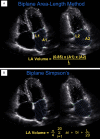Heart failure with preserved ejection fraction - unwinding the diagnosis mystique
- PMID: 25360388
- PMCID: PMC4212885
Heart failure with preserved ejection fraction - unwinding the diagnosis mystique
Abstract
A precise diagnosis of diastolic dysfunction is often difficult and requires invasive techniques to determine left ventricular volume, relaxation, and compliance properties. At this current point of time there is no single non-invasive index available to adequately reflect diastolic function, perhaps because of the numerous factors that can alter diastolic function. In most clinical settings, diastolic function is estimated using Doppler echocardiography. Cardiac magnetic resonance imaging (CMRI) is yet another emerging modality for diastolic function analysis. Here we present a comprehensive review of the various parameters used to assess diastolic function as part of diagnosis of clinical syndrome "Heart failure with preserved ejection fraction (HFPEF)".
Keywords: Diastolic dysfunction; HFNEF; HFPEF; echocardiography.
Figures




References
-
- van Kraaij DJ, van Pol PE, Ruiters AW, de Swart JB, Lips DJ, Lencer N, Doevendans PA. Diagnosing diastolic heart failure. Eur J Heart Fail. 2002;4:419–430. - PubMed
-
- Kitzman DW. Exercise intolerance. Prog Cardiovasc Dis. 2005;47:367–379. - PubMed
-
- Little WC, Kitzman DW, Cheng CP. Diastolic dysfunction as a cause of exercise intolerance. Heart Fail Rev. 2000;5:301–306. - PubMed
-
- Brubaker PH, Marburger CT, Morgan TM, Fray B, Kitzman DW. Exercise responses of elderly patients with diastolic versus systolic heart failure. Med Sci Sports Exerc. 2003;35:1477–1485. - PubMed
-
- Kitzman DW, Daniel KR. Diastolic heart failure in the elderly. Clin Geriatr Med. 2007;23:83–106. - PubMed
Publication types
LinkOut - more resources
Full Text Sources
Other Literature Sources
